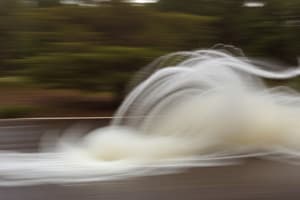Podcast
Questions and Answers
Motion is defined as a change in the (speed/position/acceleration) of an object relative to (its speed/its velocity/ a reference point).
Motion is defined as a change in the (speed/position/acceleration) of an object relative to (its speed/its velocity/ a reference point).
position, a reference point
Which is not an example of acceleration?
Which is not an example of acceleration?
- slowing down
- changing direction
- speeding up
- maintaining a constant speed (correct)
Mia was playing catch with her younger brother in the yard. What is the best example of a reference point that could be used to show that their ball was in motion?
Mia was playing catch with her younger brother in the yard. What is the best example of a reference point that could be used to show that their ball was in motion?
- the sun
- Mia (correct)
- the ball
- the speed of the ball is 2 meters per second
Match each example to the appropriate term. Answer choices: speed, velocity, and acceleration
Match each example to the appropriate term. Answer choices: speed, velocity, and acceleration
Select the equation below that would be used to calculate speed.
Select the equation below that would be used to calculate speed.
An object at rest will remain at ______ and an object in motion will remain in ______ unless acted on by a(n) ______ force.
An object at rest will remain at ______ and an object in motion will remain in ______ unless acted on by a(n) ______ force.
Select the situation below that is the best example of Newton's 1st Law of Motion.
Select the situation below that is the best example of Newton's 1st Law of Motion.
When the front of the car hits the wall at the bottom of the ramp, the car will (______ / continue moving forward until an outside force stops it / return to the top of the ramp).
When the front of the car hits the wall at the bottom of the ramp, the car will (______ / continue moving forward until an outside force stops it / return to the top of the ramp).
However, because the toy panda is not wearing a seat belt or attached to the car, it will (stop moving when the car stops / ______ / return to the top of the ramp).
However, because the toy panda is not wearing a seat belt or attached to the car, it will (stop moving when the car stops / ______ / return to the top of the ramp).
Flashcards
Motion definition
Motion definition
A change in an object's position relative to a reference point.
Acceleration example
Acceleration example
A change in velocity, which includes changing speed and/or direction.
Non-acceleration example
Non-acceleration example
Maintaining a constant speed in a straight line.
Reference point
Reference point
Signup and view all the flashcards
Speed calculation
Speed calculation
Signup and view all the flashcards
Speed unit
Speed unit
Signup and view all the flashcards
Velocity
Velocity
Signup and view all the flashcards
Acceleration Unit
Acceleration Unit
Signup and view all the flashcards
Newton's 1st Law
Newton's 1st Law
Signup and view all the flashcards
Inertia
Inertia
Signup and view all the flashcards
Newton's 1st Law Example (best)
Newton's 1st Law Example (best)
Signup and view all the flashcards
External Force
External Force
Signup and view all the flashcards
Object in motion
Object in motion
Signup and view all the flashcards
Object at rest
Object at rest
Signup and view all the flashcards
Car hitting wall
Car hitting wall
Signup and view all the flashcards
Study Notes
Motion and Acceleration
- Motion is a change in an object's position relative to a reference point.
- Acceleration is a change in velocity.
- Velocity combines speed and direction.
- Constant speed does not imply constant velocity (changing direction = acceleration).
Examples of Acceleration
- Changing speed (speeding up or slowing down).
- Changing direction.
Reference Point
- A reference point is a stationary object used to determine if something is moving.
- Examples include the sun, a tree, or a building.
Speed and Velocity
- Speed is how fast an object is moving.
- Velocity is speed in a given direction.
- Speed is calculated as distance over time (Speed = distance ÷ time).
Newton's First Law of Motion
- An object at rest stays at rest and an object in motion stays in motion with the same speed and in the same direction unless acted upon by an unbalanced force (inertia).
- Examples of this include things like objects remaining in place or objects continuing motion until an action changes the motion.
Studying That Suits You
Use AI to generate personalized quizzes and flashcards to suit your learning preferences.




